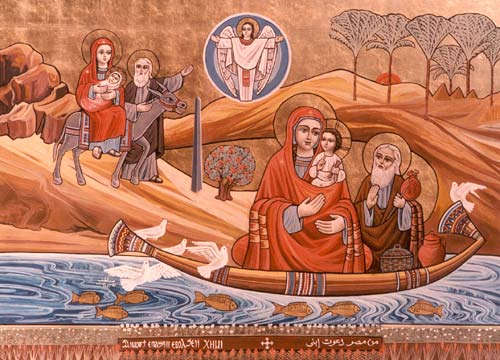Christians in Egypt, Egyptian
Christian History
According to tradition, Saint Mark brought Christianity to Egypt in the reign
of the Roman emperor Nero in the first century. Some of the early converts to
the new faith came from within the Jewish community in Egypt, which represented
the largest concentration outside of Palestine at that time.
Christianity spread throughout Egypt within half a century of Saint Mark's
arrival in Alexandria, as is clear form the New Testament writings found in
Bahnasa in Middle Egypt, which date around the year 200 AD, and a fragment of
the Gospel of Saint John, which was founded in Upper Egypt. The Gospel is
written in Coptic and dates back to the first half of the second century.
The word Coptic is derived from the Arabic corruption of the Greek "Aigyptas"
which was derived from "Hitaptah" one of the names for Memphis the
first capital of ancient Egypt. The modern use of the term Coptic refers to the
Christian Egyptians.
In its early years in Egypt, Christianity was engaged in a lengthy struggle
against the indigenous pagan religious practices descending from ancient times
as well as against Hellenism which had started in Alexandria and other urban
centers. To counter the appeal of Greek philosophy the Christian leadership in
Egypt established the Cathecal School of Alexandria (the Didascalia) which
provided intellectual refutations of Greek philosophers and sophisticated
advocacy of Christianity. Nonetheless, the transformation of Egypt into a
Christian country was not an entirely smooth process. There was resistance from
the pagan and Hellenized elements of the population, and there were divisions
within the Christian Church itself between advocates of the various theological
schools evolving at this time, due to several incidents that occurred (the
burning in 391AD of the pagan cult center). It is obvious that the dominance of
the new religion was gained at the expense of the intellectual heterogeneity
that had distinguished the city.
The pre-Islamic period for the Copts was marked by two major events, the
beginning of the Coptic calendar in AD 284, in commemoration of the persecution
suffered by Egypt's Christians and the establishment of an independent Egyptian
Church in 451 AD, following the council of Chalcedon which condemned the
monphysite theology. Thereafter the relations between Egypt's Copts and
Constantinople were strained as the Copts refused to recognize the religious
authority of the Patriarchs of Alexandria appointed by the Byzantine State.
These clerics were given widespread administrative power, in 550 AD, against the
political and the religious dominance of Egypt by the outsiders. This opposition
may in part account for the Copts acceptance of the Muslim conquest in 640 AD
who saw the Muslims as liberators from the Byzantine yoke.
In its spread in Egypt, Christianity had seen the development of hermeticism;
the voluntary retreat of religious men and women in Egypt. The monastic
tradition in fact antedated Christianity in Egypt. The Christian anchorites were
distinguished from the Jewish ones by the extremes of asceticism the pursued.
Such individuals as Anthony (AD 252-357) and Paul (AD 235-341) led lives of
total deprivation cut off as much as possible from all human contact.
In the 4th century, monasticism developed as an organized movement under the
direction of Pachomius. Pachomius gathered monks into religious communities
under strict discipline and the direction of a spiritual head. These communities
were located in both urban and rural settings. They had two forms; monasteries
where the monks lived together as a group, and Lauras cells isolated from the
main monastery physically but under its jurisdiction.
Aside from their religious and theological role, the monasteries became in
time a part of the Egyptian economy during the Christian era, producing items
which its quality were highly priced. By the time of the Muslim conquest the
monasteries had also assumed a role in local administration as tax collectors
and overseers of government policy in rural areas.
Coptic monasteries survived down to modern times as places of contemplation,
learning, scholarship and retreat, though in the twentieth century far fewer
young men have been drawn into the monastic life.

Back to History page |